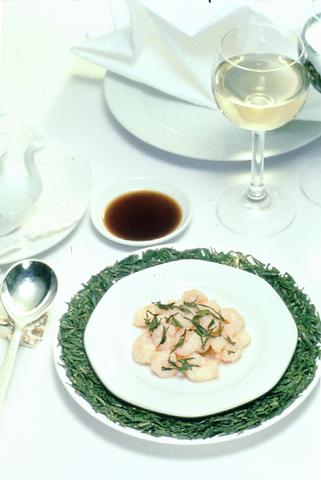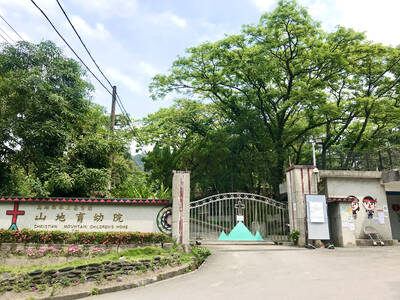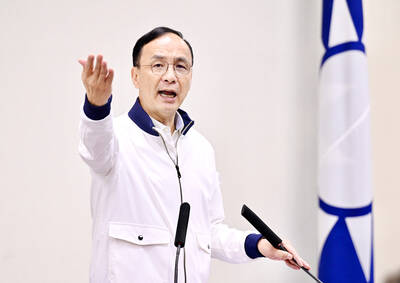For many in Taipei, Tien Hsiang Lo is a synonym for Hangchow cuisine, which, to many gourmands, is also a synonym for unique and exquisite delicacies. The original Tien Hsiang Lo restaurant in Hangchow dates back more than 100 years.
After the Chinese Civil War, in 1949, the main chefs of this famed restaurant fled to Hong Kong where they established the equally famous Hong Kong Tien Hsiang Lo. Thirteen years ago Stanley Yen (嚴長壽), president of Taipei's five-star Ritz Landis, dispatched chefs to Hong Kong with a mission to learn classic Hangchow cuisine from the chefs of the original Tien Hsiang Lo. Under a cooperative agreement, they returned to set up their own Tien Hsiang Lo in Taipei. The two restaurants are widely recognized as offering the best Hangchow cuisine in the world.

PHOTO: COURTESY OF RITZ LANDIS,TAIPEI
Hangchow cuisine can be summed up with the phrase "southern ingredients, northern style" (南菜北烹). This means that the varieties of fish, shrimp, and other crustaceans in Hangchow's much-celebrated historic West Lake are prepared in northern-style, sweet and sour-based flavors. Hangchow cuisine can be traced to 800 years ago, when the Sung dynasty moved its capital from the north to Hangchow, fleeing foreign invaders. The royal chefs, who had been accustomed to northern cuisine, had to make use of local materials. Hangchow style is, therefore, a kind of ancient imperial cuisine.
Sauted shrimp with long-ching tea leaves (龍井蝦仁) is a delightful representative Hangchow dish. Instead of using vegetables, the chefs saute the shrimp with freshly pickled long-ching tea leaves. The shrimp come out white and tender, while the tea leaves add an elegant presentation and delicate taste.
Madame Sung's fish soup (宋嫂魚湯) is a typical "southern ingredients, northern style" dish, according to Yang Kuang-tsung (楊光宗), sous chef of the hotel. This southern version of sour and spicy soup adds more vegetables and has abundant boneless fresh-water fish, mushrooms, egg yolk, bamboo shoots and a dash of Shaoshing wine.
One distinct plus about Tien Hsiang Lo is that dishes are presented in individual portions, which allows diners to sample a variety of flavors without having to order more food than one person can eat.
Autumn is also the best season to feast on giant fresh-water crabs, another Hangchow delicacy.

May 18 to May 24 Pastor Yang Hsu’s (楊煦) congregation was shocked upon seeing the land he chose to build his orphanage. It was surrounded by mountains on three sides, and the only way to access it was to cross a river by foot. The soil was poor due to runoff, and large rocks strewn across the plot prevented much from growing. In addition, there was no running water or electricity. But it was all Yang could afford. He and his Indigenous Atayal wife Lin Feng-ying (林鳳英) had already been caring for 24 orphans in their home, and they were in

On May 2, Chinese Nationalist Party (KMT) Chairman Eric Chu (朱立倫), at a meeting in support of Taipei city councilors at party headquarters, compared President William Lai (賴清德) to Hitler. Chu claimed that unlike any other democracy worldwide in history, no other leader was rooting out opposing parties like Lai and the Democratic Progressive Party (DPP). That his statements are wildly inaccurate was not the point. It was a rallying cry, not a history lesson. This was intentional to provoke the international diplomatic community into a response, which was promptly provided. Both the German and Israeli offices issued statements on Facebook

Even by the standards of Ukraine’s International Legion, which comprises volunteers from over 55 countries, Han has an unusual backstory. Born in Taichung, he grew up in Costa Rica — then one of Taiwan’s diplomatic allies — where a relative worked for the embassy. After attending an American international high school in San Jose, Costa Rica’s capital, Han — who prefers to use only his given name for OPSEC (operations security) reasons — moved to the US in his teens. He attended Penn State University before returning to Taiwan to work in the semiconductor industry in Kaohsiung, where he

Australia’s ABC last week published a piece on the recall campaign. The article emphasized the divisions in Taiwanese society and blamed the recall for worsening them. It quotes a supporter of the Taiwan People’s Party (TPP) as saying “I’m 43 years old, born and raised here, and I’ve never seen the country this divided in my entire life.” Apparently, as an adult, she slept through the post-election violence in 2000 and 2004 by the Chinese Nationalist Party (KMT), the veiled coup threats by the military when Chen Shui-bian (陳水扁) became president, the 2006 Red Shirt protests against him ginned up by